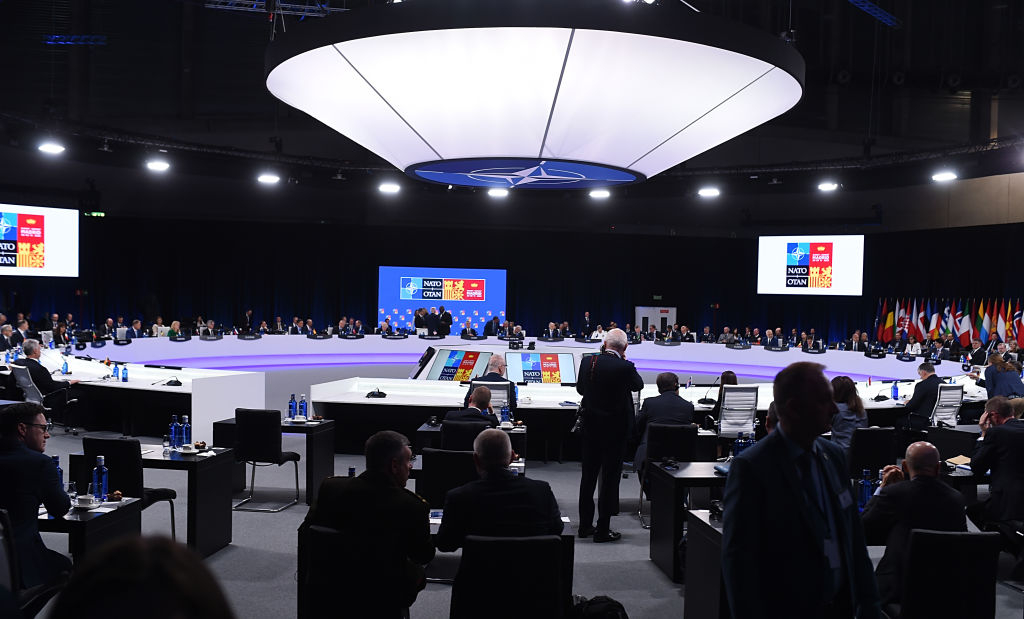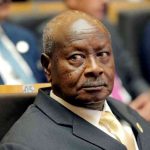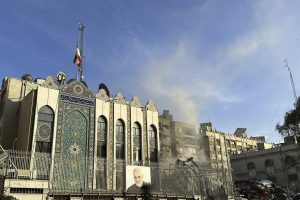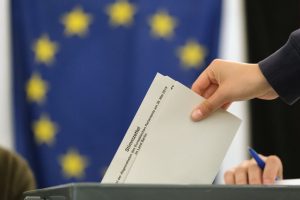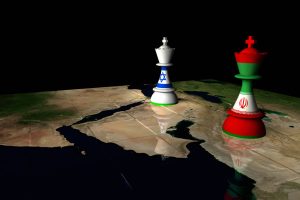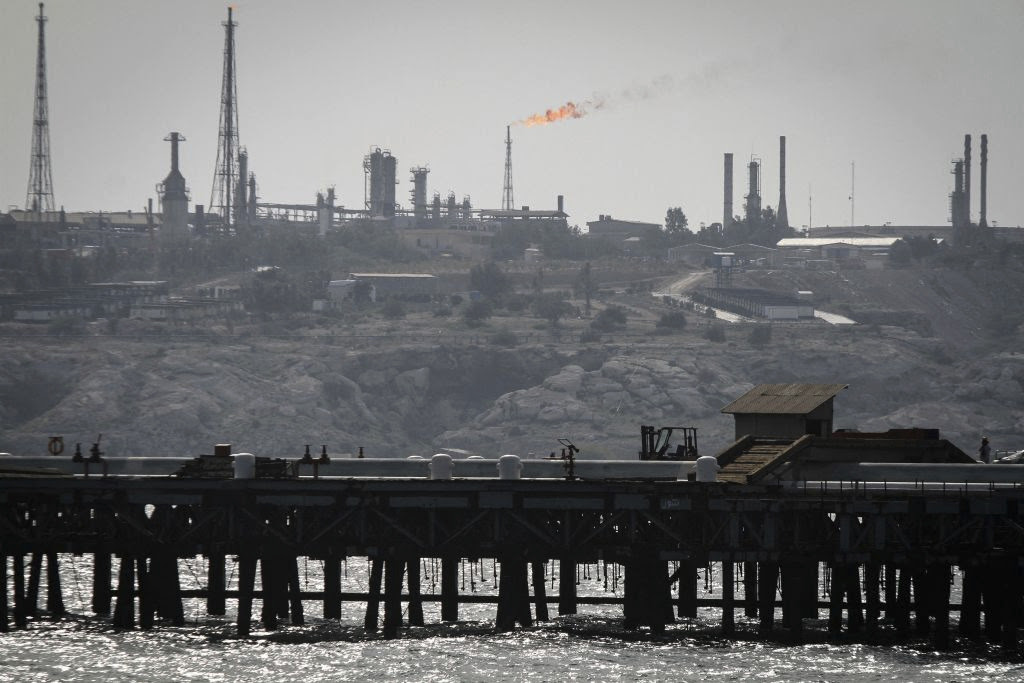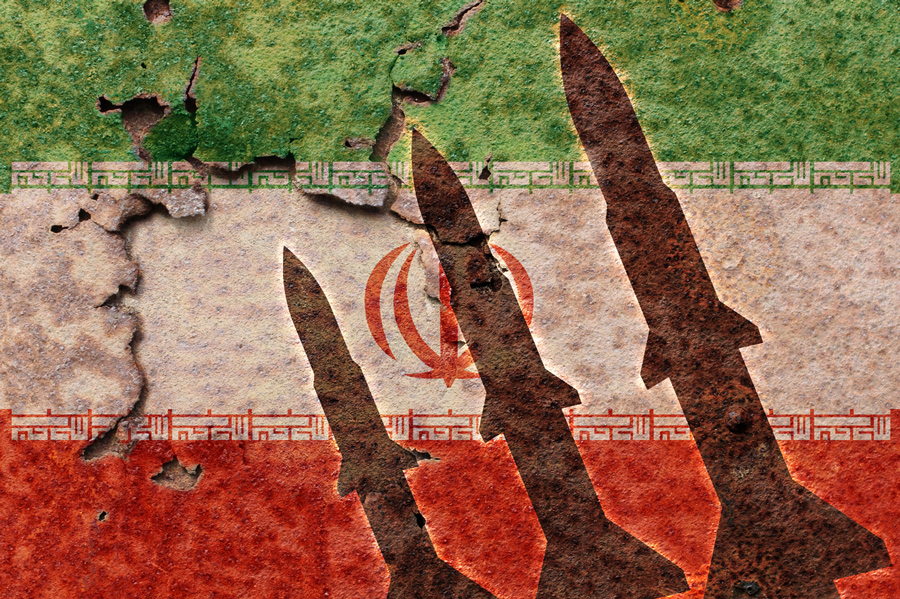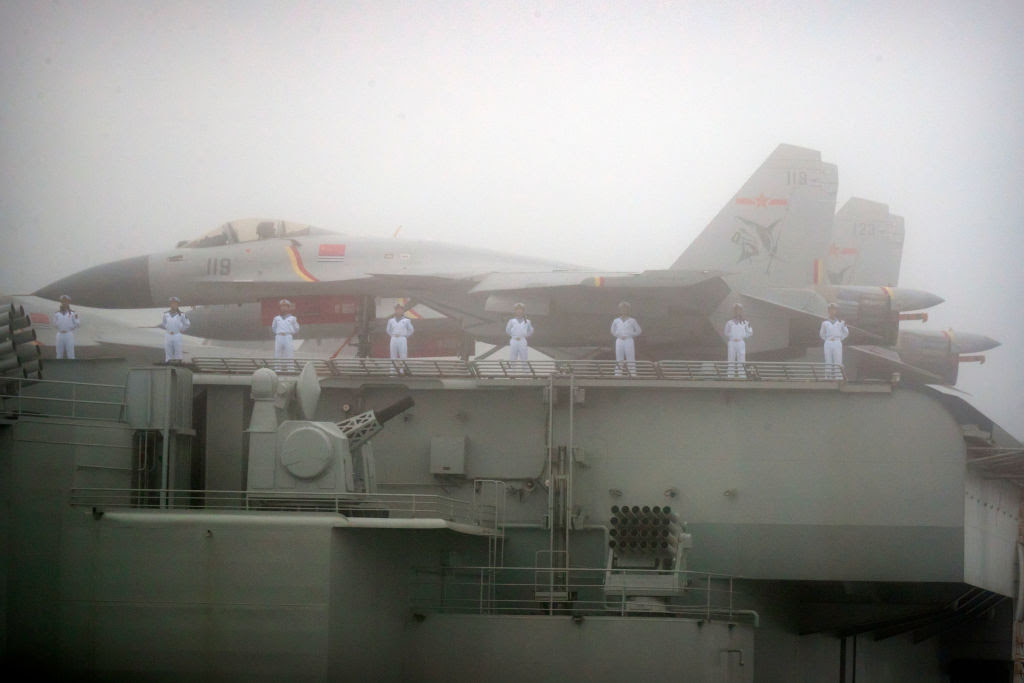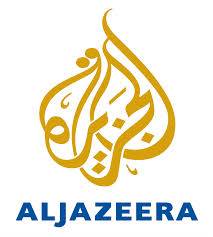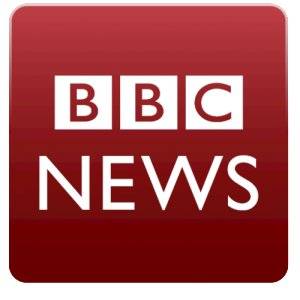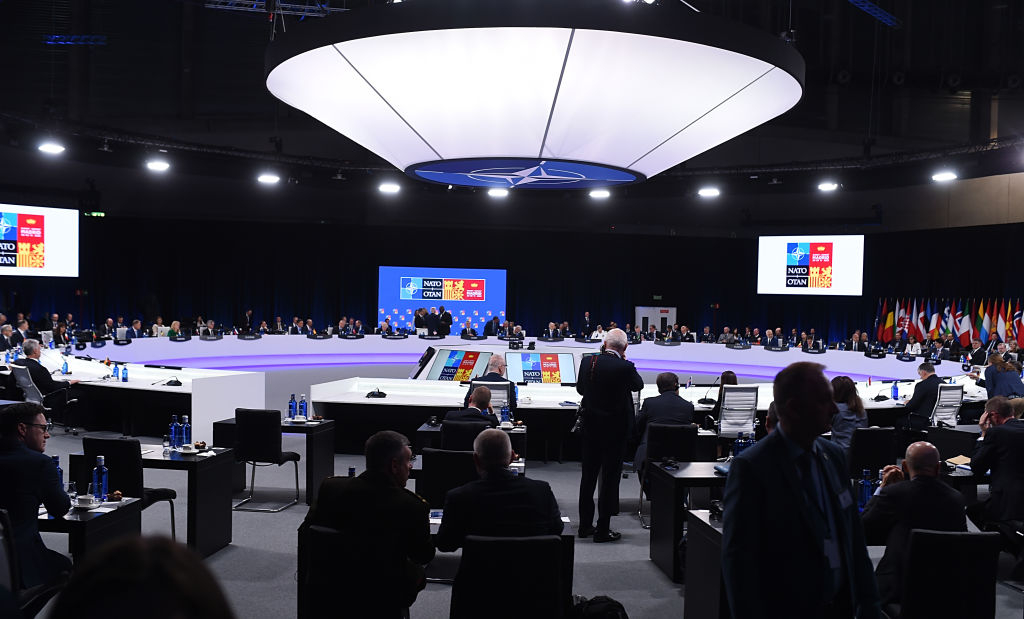 NATO’s new Strategic Concept, adopted at the NATO Summit in Madrid on June 28-30 (pictured), focuses on addressing the return of great-power politics, specifically strategic competition with revisionist powers such as Russia and China. (Photo by Denis Doyle/Getty Images) NATO’s new Strategic Concept, adopted at the NATO Summit in Madrid on June 28-30 (pictured), focuses on addressing the return of great-power politics, specifically strategic competition with revisionist powers such as Russia and China. (Photo by Denis Doyle/Getty Images) |
The North Atlantic Treaty Organization (NATO), responding to Russia’s war of aggression against Ukraine, has announced the biggest overhaul of European defense since the end of the Cold War. By pledging more money, more troops and more unity to deter Russia, NATO leaders have reaffirmed NATO as the cornerstone of transatlantic defense.
The alliance’s new Strategic Concept, adopted at the NATO Summit in Madrid on June 28-30, focuses on addressing the return of great-power politics, specifically strategic competition with revisionist powers such as Russia and China.
The document, which sets out the alliance’s priorities, core tasks and approaches for the next decade, identifies Russia as the “most significant and direct threat” to Western security and warns that China’s “stated ambitions and coercive policies” challenge Western “interests, security and values.” It adds that Moscow and Beijing increasingly are working together “to undercut the rules-based international order.”
The Strategic Concept affirms collective territorial defense as NATO’s fundamental mission, and effective deterrence as its main objective:
“While NATO is a defensive Alliance, no one should doubt our strength and resolve to defend every inch of Allied territory, preserve the sovereignty and territorial integrity of all Allies and prevail against any aggressor.”
The Madrid Summit Declaration, issued by NATO heads of state and government on June 29, stressed that NATO’s Article 5 — the principle that an attack against one member of NATO is an attack on all members — is “iron-clad” and reiterated that the alliance “will defend every inch of Allied territory at all times.”
NATO also formally invited Finland and Sweden to join the alliance; increased the number of NATO high readiness troops seven-fold to “well over” 300,000; doubled the number of multinational battlegroups along NATO’s eastern flank from four to eight; and enhanced the battlegroups to brigade levels. In addition, the United States announced that it will establish a permanent military base in Poland.
Russia’s invasion of Ukraine has been a strategic wake-up call that, thankfully, appears to be revitalizing NATO and bolstering transatlantic unity. There are, however, unanswered questions:
- Will NATO be able to sustain its newfound unity of purpose over the medium to long term, especially if Russia cuts off gas supplies to Europe this winter?
- Will NATO’s infamous Russia appeasers — France, Germany and Italy — maintain a sustained united front against Moscow if that stance threatens future economic, financial or trade opportunities?
- Will NATO’s notorious free-riders — especially Germany, Italy and Spain — match reality with rhetoric and increase defense spending over the long term?
- Will the European members of NATO accept a rebalanced transatlantic partnership in which they shoulder more responsibility for their own defense?
2022 Strategic Concept
The 2022 Strategic Concept adopted in Madrid updates the 2010 Strategic Concept, which became moribund after Russia’s invasion of Crimea in 2014. The two documents are starkly different and reflect fundamental changes in the global security environment, especially regarding Russia and China:
- 2010 Concept: “Today, the Euro-Atlantic area is at peace and the threat of a conventional attack against NATO territory is low.”2022 Concept: “The Euro-Atlantic area is not at peace.”
- 2010 Concept: “NATO-Russia cooperation is of strategic importance as it contributes to creating a common space of peace, stability and security…. NATO poses no threat to Russia. On the contrary: we want to see a true strategic partnership between NATO and Russia, and we will act accordingly, with the expectation of reciprocity from Russia.”2022 Concept: “The Russian Federation has violated the norms and principles that contributed to a stable and predictable European security order. We cannot discount the possibility of an attack against Allies’ sovereignty and territorial integrity.”
- 2010 Concept: “Notwithstanding differences on particular issues, we remain convinced that the security of NATO and Russia is intertwined and that a strong and constructive partnership based on mutual confidence, transparency and predictability can best serve our security.”2022 Concept: “The Russian Federation is the most significant and direct threat to Allies’ security and to peace and stability in the Euro-Atlantic area. It seeks to establish spheres of influence and direct control through coercion, subversion, aggression and annexation. It uses conventional, cyber and hybrid means against us and our partners. Its coercive military posture, rhetoric and proven willingness to use force to pursue its political goals undermine the rules-based international order…. In light of its hostile policies and actions, we cannot consider the Russian Federation to be our partner.”
The 2022 Concept also assesses, for the first time, the “challenges” — France and Germany objected to describing China as a “threat” because it was seen as harmful to their economic interests — posed by Communist Party of China:
“The People’s Republic of China’s (PRC) stated ambitions and coercive policies challenge our interests, security and values. The PRC employs a broad range of political, economic and military tools to increase its global footprint and project power, while remaining opaque about its strategy, intentions and military build-up.
“The PRC’s malicious hybrid and cyber operations and its confrontational rhetoric and disinformation target Allies and harm Alliance security…. It strives to subvert the rules-based international order, including in the space, cyber and maritime domains.
“The deepening strategic partnership between the People’s Republic of China and the Russian Federation and their mutually reinforcing attempts to undercut the rules-based international order run counter to our values and interests.”
The 2022 Concept states that “terrorism, in all its forms and manifestations, is the most direct asymmetric threat to the security of our citizens and to international peace and prosperity.”
The 2022 Concept maintains the core tasks of NATO outlined in the 2010 Concept: 1) deterrence and defense; 2) crisis prevention and management; and 3) cooperative security (partnerships with non-NATO countries). The 2022 Concept differs in that it places far more emphasis than previously on collective defense and deterrence, especially deterrence by denial (deterring potential aggressors by making it unfeasible for them to succeed):
“We will significantly strengthen our deterrence and defense posture to deny any potential adversary any possible opportunities for aggression. To that end, we will ensure a substantial and persistent presence on land, at sea, and in the air, including through strengthened integrated air and missile defense. We will deter and defend forward with robust in-place, multi-domain, combat-ready forces, enhanced command and control arrangements, prepositioned ammunition and equipment and improved capacity and infrastructure to rapidly reinforce any Ally, including at short or no notice.”
The 2022 Concept also stresses the centrality of nuclear weapons for NATO’s deterrence posture:
“The strategic nuclear forces of the Alliance, particularly those of the United States, are the supreme guarantee of the security of the Alliance. The independent strategic nuclear forces of the United Kingdom and France have a deterrent role of their own and contribute significantly to the overall security of the Alliance. These Allies’ separate centres of decision-making contribute to deterrence by complicating the calculations of potential adversaries. NATO’s nuclear deterrence posture also relies on the United States’ nuclear weapons forward-deployed in Europe and the contributions of Allies concerned. National contributions of dual-capable aircraft to NATO’s nuclear deterrence mission remain central to this effort.”
The 2022 Concept stresses that NATO is the “unique, essential and indispensable” forum for “all matters related to our individual and collective security.” This statement would appear to effectively end, at least for now, the long-running ideological debate over the European Union’s ambitions to achieve “strategic autonomy” from the United States.
The 2022 Concept also stresses the importance of the Indo-Pacific region to NATO:
“The Indo-Pacific is important for NATO, given that developments in that region can directly affect Euro-Atlantic security. We will strengthen dialogue and cooperation with new and existing partners in the Indo-Pacific to tackle cross-regional challenges and shared security interests.”
Finally, the 2022 Concept commits NATO member states to honor previous pledges on defense spending, but there is no enforcement mechanism:
“We will share equitably responsibilities and risks for our defense and security. We will provide all the necessary resources, infrastructure, capabilities and forces to deliver fully on our core tasks and implement our decisions. We will ensure our nations meet the commitments under the Defense Investment Pledge, in its entirety, to provide the full range of required capabilities. We will build on the progress made to ensure that increased national defense expenditures and NATO common funding will be commensurate with the challenges of a more contested security order.”
At the 2014 NATO Summit in Wales, allies agreed to spend a minimum of 2% percent of their gross domestic product (GDP) to defense spending. In 2022, only eight of NATO’s 30 member states honored their pledges, according to data supplied by NATO.
Germany — the EU’s biggest economy — spent only 1.49% of GDP on defense in 2021. That represents an increase of less than 0.5% of GDP since 2015. France, the EU’s second-biggest economy, spent 1.93% of GDP on defense in 2021, an increase of only 0.3% of GDP since 2015. Italy, the EU’s third-biggest economy, spent 1.54% of GDP on defense in 2021, while Spain, the EU’s fourth-biggest economy, spent a mere 1.03% of GDP on defense in 2021, according to NATO data. The numbers show that defense spending is not a priority in most European countries.
Fundamental Shift
At the Madrid Summit, U.S. President Joe Biden and NATO Secretary General Jens Stoltenberg outlined (here and here) how the alliance has reset its deterrence and defense posture in response to Russia’s invasion of Ukraine:
- More forward deployed combat formations. NATO has enhanced its presence in Eastern Europe with eight multinational battlegroups in Bulgaria, Estonia, Hungary, Latvia, Lithuania, Poland, Romania and Slovakia. Their presence is intended make clear that an attack on one ally will be considered an attack on the entire alliance. NATO’s battlegroups form part of the biggest reinforcement of NATO’s collective defense in a generation.
- More high-readiness forces. At the Madrid Summit, leaders agreed to a new NATO Force Model, which will deliver an allied response at much greater scale and at higher readiness than the current NATO Response Force, which it will replace. Under the current system, allies can make approximately 40,000 troops available at less than 15 days readiness. When fully implemented, the NATO Force Model will provide well over 300,000 troops at high readiness. The transition is expected to be completed in 2023.
- More pre-positioned equipment. NATO leaders agreed to pre-position more equipment and weapon stockpiles in the eastern parts of the alliance. The move is aimed to enhance NATO’s eight multinational battlegroups.
- More U.S. permanent presence Europe. Biden announced that the United States will establish its first permanent presence in Poland. He said the U.S. will permanently station the U.S. Army Fifth Corps forward command in Poland, a move that will strengthen U.S.-NATO interoperability across Eastern Europe.
- More U.S. troops to Europe. Biden also said that the United States will also send two additional F-35 fighter jet squadrons to the United Kingdom, boost the fleet of U.S. naval destroyers in Spain from four to six, deploy an additional 5,000 troops to Romania, and send additional air defense and other capabilities to Germany and Italy. The United Kingdom also pledged to send 1,000 more troops to Estonia, in addition to the 2,000 British troops already in the country.
- More NATO members. In what marks one of the biggest shifts in European security in decades, NATO leaders agreed to invite the previously neutral Nordic states Finland and Sweden into the alliance. Their membership must be ratified by the governments of all 30 NATO members. The ratification process is expected to take up to one year. After the accession of Finland and Sweden, Austria, Cyprus, Ireland and Malta will be the only EU members that are not members of NATO.
At a news conference to mark the conclusion of the Madrid Summit, Stoltenberg said that NATO was facing “the most serious security situation in decades” and that alliance leaders had agreed to a “fundamental shift” in deterrence and defense:
“We have so significantly increased our presence in the eastern part of the Alliance — with more than 40,000 troops under direct NATO command — to remove any room for miscalculation, misunderstanding in Moscow about our readiness to protect every inch of NATO territory.”
Expert Commentary
German analyst Ulrich Speck wrote that the Russian invasion of Ukraine has given NATO a new lease on life:
“Instead of being braindead or becoming obsolete, NATO remains at the center of European security. We realize that NATO is not just a Cold War institution that has outlived its purpose; it remains very relevant, as Central Europeans always knew and as the West now fully realizes.
“The core task of NATO is defense and deterrence against Russia, which has adopted an expansionist, revisionist, imperialist identity — instead of accepting the nation state as the new normal in the region, and with it territorial integrity and safe borders….
“To keep NATO strong, Europeans must ‘own’ NATO, fill it with life. The question of burden sharing is more relevant than ever; as the US is focusing on Asia. Yet to push back against Russia, the US remains indispensable, as the Russian war against Ukraine demonstrates once more.”
In an opinion article — “Biden’s NATO Summit To-Do List” — the Editorial Board of the Wall Street Journal called on the Biden administration to pressure Europeans to do more for their own defense:
“There are already 100,000 U.S. troops in Europe, and other NATO members appear unwilling or unable to fulfill the Baltic countries’ request for significantly more troops and maritime and air defenses. European allies could do more for more vulnerable states if they spent more on defense. Last year was the seventh in a row that military expenditures increased across Europe and Canada, according to NATO data, but only eight nations met the spending target of 2% of gross domestic product.
“The February invasion led to promises for even more spending, but many countries remain disappointments. Last month Germany approved a special €100 billion fund to rearm but still won’t commit to meeting the spending pledge every year. Italy said in March it will hit 2% by 2028, and Belgium managed to be even more hapless with a vow to reach the goal by 2035. Will Mr. Biden do anything to push these laggards in Madrid?”
In an article — “Strategic Responsibility: Rebalancing European and Trans-Atlantic Defense” —published by the Brookings Institution, analysts Hans Binnendijk, Daniel S. Hamilton and Alexander Vershbow called on European members of NATO to assume greater strategic responsibility but in a way that bolsters the alliance:
“While Russian President Vladimir Putin’s war of aggression against Ukraine has reinvigorated the Atlantic alliance, it has also deepened Europe’s strategic dependence on the United States. As North Atlantic Treaty Organization (NATO) allies continue to help Ukraine beat back Russia’s assault, they must also address this important longer-term challenge of rebalancing trans-Atlantic defense. Doing so means squaring a triangle of issues: ensuring Europe’s capacity to defend itself against Russia and manage a range of additional crises, many along its southern periphery; addressing European aspirations for greater strategic autonomy; and maintaining confidence that the United States can adequately uphold its commitments in both the north Atlantic and the Indo-Pacific.
“Advancing greater European strategic responsibility starts by defining the concept in a way designed to strengthen the Atlantic alliance. It should focus on two military goals. First, European allies should build their conventional military capabilities to a level that would provide half of the forces and capabilities, including the strategic enablers, required for deterrence and collective defense against major-power aggression. Second, European allies should develop capabilities to conduct crisis management operations in Europe’s neighborhood without today’s heavy reliance on U.S. enablers such as strategic lift, refueling, and command, control, communications, computers, intelligence, surveillance, and reconnaissance (C4ISR).
“Meeting these two goals would allow Europe to become the first responder to most crises in its neighborhood, acting through NATO, through the EU, or through ad hoc coalitions of the willing. It would permit the United States to shift some of its forces and strategic focus to the Indo-Pacific region without any significant reduction in the capabilities needed to deter Russia.”
In an essay — “Europe Has an America Problem” — Emma Ashford, an analyst with the Atlantic Council, wrote:
“Four months after Russia’s invasion of Ukraine, NATO stands as a re-energized bulwark against Russian aggression. European leaders across the continent, determined to come together, speak confidently of common purpose.
“Yet for all the talk of European resolve, the past few months have in fact underlined something else: the continent’s dependence on the United States to resolve its security problems. That’s nothing new, of course. In many ways it’s the role America has played since the end of World War II, ensuring — even after the collapse of the Soviet Union in 1991 — that Europe operated under America’s military umbrella.
“But while this approach might save leaders from politically difficult choices in the short term, it’s ultimately a losing proposition. America, embroiled in domestic problems and ever more focused on the challenge from China, can’t oversee Europe forever. And Europe, facing a hostile and revisionist Russia, needs to look after itself….
“If European states are reducing their free-rider problem, they have something perhaps more intractable: a collective-action problem. Simply put, the individual interests and inclinations of the European Union’s 27 members, whose countries encompass several thousand miles of territory, make it difficult to forge a common course of action. That’s true for many issues, among them economic reform and the role of the judiciary, but it’s perhaps especially acute for military and defense policy….
“Central and Eastern European states closest to Russia logically view it as the biggest threat. From farther away, other problems loom larger. Germany and Northern European countries worry about terrorism, France focuses on extremism and unrest in former African colonies like Mali, while Greece and Italy are preoccupied by refugee policy and maritime security in the Mediterranean….
“In the absence of continental consensus, the glue that continues to hold together European security is the United States. Since February, the trans-Atlantic relationship has slid back into a comfortable groove: The United States provides significant personnel and high-tech weaponry, forestalling the need for other NATO members to commit substantial resources or make tough choices about joint defense.
“Politically, America’s presence reassures NATO members in Eastern Europe — who have become painfully aware since February that Western European states aren’t as willing to take a hard line on Russia — while allowing Germany to lead Europe without bearing too great a financial and military cost. The underlying disagreements haven’t gone away. But for as long as American troops and hardware are on the continent, European states can have their cake and eat it, too.”
In commentary — “New Concepts but Old Problems: NATO’s New Strategic Concept” — Ed Arnold, an analyst at the Royal United Services Institute, a British think tank, concluded that NATO’s greatest challenge will be in translating political rhetoric into action:
“These [NATO] announcements are politically momentous, but also entail a huge risk. The big troop increases will be very expensive as member states experience increasing spending pressures. If these statements are not backed up (there are a total of 71 ‘we will’ commitments across 11 pages), the Alliance could lose trust and credibility, and therefore effective deterrence….
“Despite Ukraine not being a member of the Alliance, the outcome of the war is critical to NATO, European security, and the principle that aggressors cannot redraw international borders by force. NATO has now stated that ‘A strong, independent Ukraine is vital for the stability of the Euro-Atlantic area,’ and it must follow through with action. However, the announced enhancements to NATO’s defense and deterrence posture will come at an eyewatering cost to NATO common funding, which will fall on national defense ministry budgets that are already under strain when it comes to delivering extant equipment budgets. Moreover, with economies hit by the coronavirus pandemic, the cost of living, and inflationary pressure, the ability to sustain political will on NATO funding will diminish….
“Russia’s 2014 annexation of Crimea was a wakeup call that the Alliance didn’t fully grasp. Some modest transformation did occur, such as the creation of the NRF and Enhanced Forward Presence, as well as the recommitment to spending 2% of GDP on defense by 2024 at the 2014 Wales summit. However, the political rhetoric was not backed by commitment, which weakened NATO deterrence and might have inadvertently influenced Putin’s decision-making calculus towards Ukraine. If NATO fails to translate words into action now, it could be fatal for the Alliance.”







